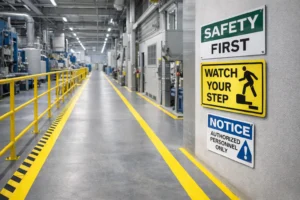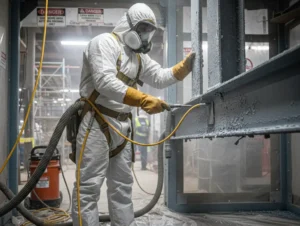Introduction: What is Process Safety Management (PSM)?
Process Safety Management (PSM) is a structured approach designed to prevent accidents involving hazardous chemicals and processes. It emphasizes identifying, evaluating, and controlling risks before they escalate into incidents. PSM (Worker and Community Protection) safeguards not only employees but also surrounding communities and the environment.
Industries like chemical, oil & gas, and manufacturing rely on PSM to manage complex operations and hazardous substances. Through proper implementation, it can help prevent fires, explosions, toxic releases, and other large-scale industrial accidents.
Moreover, in the U.S., OSHA’s standard 29 CFR 1910.119 sets mandatory requirements for facilities handling hazardous chemicals. While OSHA is U.S.-based, many international organizations have adopted similar PSM frameworks to ensure safety worldwide.
Identifying Hazards with Process Hazard Analysis (PHA)
Process Hazard Analysis (PHA) is a structured approach to identifying potential hazards in industrial processes that could lead to fires, explosions, or toxic releases. It is essential because it helps organizations proactively recognize risks before they turn into costly or life-threatening incidents.
About the common PHA methods, it include HAZOP (Hazard and Operability Study), which is a systematic review of processes to identify deviations. Secondly, it has a What-If Analysis that is about brainstorming "what if" scenarios to uncover possible failures. Thirdly, there is a checklist that shows industry-standard lists to ensure critical safety aspects are reviewed. And lastly, mapping possible causes leading to a specific hazardous event.
OSHA and industry best practices recommend revalidating Process Hazard Analysis every five years or sooner when significant process changes occur. When it comes to having a successful PHA, it requires a multidisciplinary team, including engineers, operators, safety professionals, and management, to bring different perspectives to hazard identification.
The outcome of a PHA is not just a report-it forms the foundation for safety decisions, guiding equipment upgrades, training, and emergency planning. Moreover, by making it a routine part of operations, organizations build a culture of safety and continuous improvement.
Starting Safe: Pre-Startup Safety Review (PSSR)
A Pre-Startup Safety Review (PSSR) is a critical checkpoint to confirm that facilities, procedures, and people are fully prepared before hazardous materials are introduced. It means making sure nothing is left to chance before operations begin. Here are the things involved in starting safe:
Purpose of PSSR
It ensures all systems, equipment, and procedures are safe and ready before hazardous materials are introduced.
Key Checkpoints
It involves the verification of equipment installation, safety devices, alarms, and controls, along with updated operating procedures and employee training.
Documentation Review
It confirms that process safety information, permits, and design records align with current operational requirements.
Integration with Readiness
It acts as a bridge between project completion and operational startup, reducing risks during handover.
Team Involvement
PSSR engages operations, maintenance, engineering, and safety personnel to capture multiple perspectives.
Common Oversights to Avoid
Some of the common oversights involve skipping training verification, neglecting emergency systems, or failing to update written procedures.
Overall Goal
The aim is to establish a strong safety foundation, preventing incidents from occurring right at the start of operations.
Ensuring Compliance Through Regular Compliance Audits
The PSM Compliance Audits are structured evaluations that measure how effectively a facility is implementing OSHA’s Process Safety Management (PSM) standards. OSHA requires audits at least every three years, but many companies conduct them more frequently to stay ahead of risks. The auditors review written procedures, employee training, process hazard analyses, mechanical integrity records, and emergency response plans.
When it comes to field verification, it goes beyond paperwork. The auditors often interview employees and observe work practices to confirm procedures are followed in real time.
As part of frequent findings, the auditors can identify incomplete documentation, outdated PHAs, or lapses in training. Facilities must create action plans to address deficiencies, assign accountability, and track completion to closure.
It's important to have regular audits. It not only ensures compliance but also builds a culture of ongoing learning and safer operations.
Preserving System Health with Mechanical Integrity
The Mechanical Integrity is a core element of OSHA’s PSM standard that ensures critical process equipment is designed, installed, and maintained to perform safely under operating conditions. It includes pressure vessels, piping systems, storage tanks, relief devices, pumps, compressors, instrumentation, and emergency shutdown systems.
It ensures that facilities must follow industry standards (eg, API, ASME) for periodic inspections, non-destructive testing, and functional checks of safety devices. The Preventive and predictive maintenance routines help detect wear, corrosion, or fatigue before failures occur.
Moreover, the maintenance of logs, calibration of records, and inspection of reports provide proof of compliance and traceability for regulators and internal teams.
A single lapse in equipment integrity can lead to leaks, fires, explosions, or toxic releases, making it one of the leading causes of catastrophic process incidents. Using sensors, reliability programs, and modern asset management systems strengthens early detection and reduces unplanned downtime.
Preserving System Health with Mechanical Integrity
The Mechanical Integrity is a core element of OSHA’s PSM standard that ensures critical process equipment is designed, installed, and maintained to perform safely under operating conditions. It includes pressure vessels, piping systems, storage tanks, relief devices, pumps, compressors, instrumentation, and emergency shutdown systems.
It ensures that facilities must follow industry standards (eg, API, ASME) for periodic inspections, non-destructive testing, and functional checks of safety devices. The Preventive and predictive maintenance routines help detect wear, corrosion, or fatigue before failures occur.
Moreover, the maintenance of logs, calibration of records, and inspection of reports provide proof of compliance and traceability for regulators and internal teams.
A single lapse in equipment integrity can lead to leaks, fires, explosions, or toxic releases, making it one of the leading causes of catastrophic process incidents. Using sensors, reliability programs, and modern asset management systems strengthens early detection and reduces unplanned downtime.
Safely Adapting with Management of Change (MOC)
MOC ensures modifications are reviewed for safety, compliance, and operational impact before implementation. It covers equipment replacements or upgrades, introduction of new chemicals, process revisions, procedural updates, and organizational/personnel shifts. Each change must be evaluated for potential risks, environmental impacts, and regulatory implications.
Moreover, initiate a change request, then conduct hazard/risk analysis, followed by review by qualified personnel. Next is document approval, followed by training affected staff and implementing safety measures for effective verification. MOC ties into process safety information, operating procedures, and training to create a complete safety net.
Investigating to Prevent Recurrence: Incident Investigation
Incident investigations are vital for learning and prevention, ensuring that organizations identify not just what happened but why it happened. Under PSM, investigations must be conducted within 48 hours of any incident that can result in a catastrophic release.
Using root cause analysis tools such as the 5 Whys or Fishbone Diagram helps uncover underlying issues beyond surface errors. Findings should be documented clearly, with corrective actions assigned, tracked, and verified to prevent recurrence and strengthen a culture of safety.
Wrap Up
Integrating Process Safety Management is not just about meeting compliance; it’s about building long-term protection for people, assets, and the environment.
A proactive approach that combines strong procedures, employee involvement, and ongoing training ensures risks are minimized before incidents occur.
If organizations commit to continuous improvement and accountability, they can create a sustainable culture of safety that drives both compliance and operational excellence.






